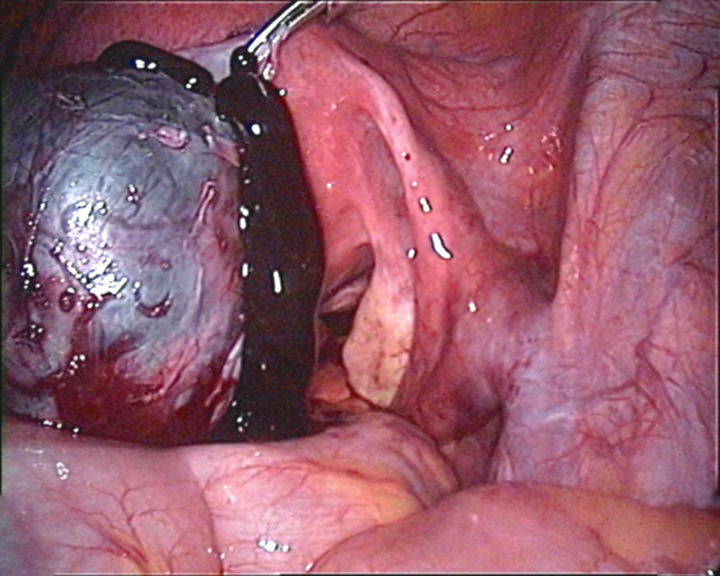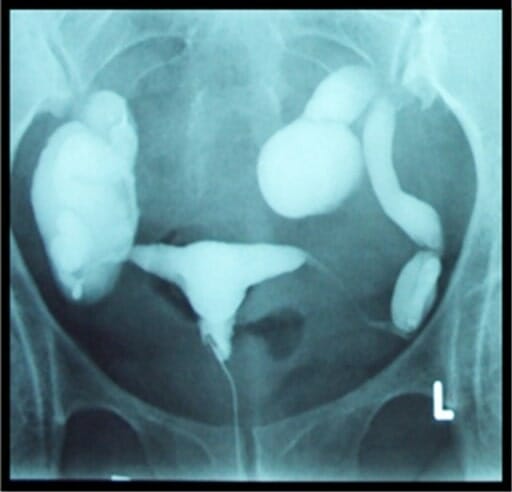Playlist
Show Playlist
Hide Playlist
Endometriosis
-
Slides Uterus Female Repro.pdf
-
Download Lecture Overview
00:01 Our topic now brings us to endometriosis. 00:04 Before I move on though, I need to make sure that we’re very clear about the different terms that look quite similar with endometriosis that you’d be responsible for and I’ll be going over all of these. 00:16 Here, endometriosis which you're quite familiar with the ectopic implantation of the endometrium and different organs. 00:22 I’ll come to their definition again but you know what I’m referring to. 00:26 If by chance you find ectopic implantation in the ovary, which is the most common site of ectopic implantation. 00:33 Where should the endometrium be normally? The uterus. 00:38 If there’s endometrial tissue on the ovary guess what you call that condition? Let me ask you something before we begin. 00:46 Is this a cancer, endometriosis? No. 00:50 It’s not. 00:51 It’s an ectopic implantation. 00:53 Someone even argued that this is a choristoma or heterotopic rest. 00:57 Whatever. 00:59 That’s really not my point. 01:00 That's neither here or there. 01:02 Really the point is it’s not a cancer. 01:05 Why am I bringing this up? Because if the most common site of ectopic implantation is on the ovary, you call this an endometrioma. 01:14 Doesn’t that awfully sound like a tumor? Wouldn’t you perhaps think that it’s a cancer? Sure. But it’s not. 01:22 So an ectopic implantation of endometrium, specifically on the ovary, is called an endometrioma. 01:29 Two that sound alike. 01:31 A third one, let’s say that you actually have an ovarian tumor. 01:36 You remember what that’s called that has a term endo in it? At some point, we’ll get into ovarian tumors. 01:42 We will be discussing endometrioid tumor. 01:46 Clear? Three. 01:48 What were they again? Endometriosis, endometrioma, endometrioid. 01:52 What if there was an inflammatory process in the endometrium? You call that endometritis. 01:58 Are we clear? If not, that’s okay. 02:01 Let me at least introduce these four terms to you and we will wall through each one. 02:05 So what is endometriosis? It’s ectopic implantation of your endometrium on different locations outside the uterus, usually pelvic. 02:14 The most common site will be the ovaries. 02:17 Now, imagine this now. 02:19 Is this ectopic implantation? Is it like normal endometrium? Meaning to say does it respond like normal endometrium? Yes, it does. 02:28 What is the hormone that’s responsible for proliferation of the endometrium? Good. Estrogen. 02:34 So here, you have ectopic implantation of the endometrium on the ovary. 02:39 You think its possible that it might actually proliferate on the ovary? Sure it can. 02:44 And you’re saying that there might be menses on top of the ovaries? That’s exactly what I’m telling you. 02:50 What do you call this? A chocolate cyst Let’s move on. 02:53 The uterine ligament, rectovaginal septum. 02:57 Look at this, look where you are. 02:59 In the rectum! You have endometrial tissue in the rectum? So that means that -- Oh, my goodness, as uncomfortable as this is, listen, there’s going to be, during your menstrual cycle, proliferation of the endometrial in the rectal pouch. 03:16 Every time she has her menstrual cycle, guess what? She’s having a hard time defecating. 03:23 It literally causes obstruction. 03:26 Where’s the most common site though? Ovaries and pelvic peritoneum. 03:31 Amazing! You’ll find this to be interesting. 03:34 When you have ectopic implantation of the endometrium on the pelvic peritoneum, you actually call this what’s known as coelomic metaplasia. 03:44 Let’s continue. 03:46 If you find ectopic implantation of your endometrium in your myometrium – “Dr. Raj, you’re really confusing me.” Listen, think uterus, the inner lining is called the endometrium. 04:03 What’s the muscle layer called? Myometrium. 04:05 Myometrium. 04:07 Same concept as the heart. 04:09 Endocarditis or endocardium. 04:12 Myocardium. 04:13 Here, we have endoemetrium and myometrium. Clear? May I ask you something, should you find the glandular structure in a muscle layer of an organ? I’m sorry, but it’s called myometrium on purpose. 04:28 Myo- means muscle. 04:30 You should have smooth muscle only in the myometrium, very little glandular structure if at all, responsible for contraction. 04:40 But what if you find glandular structure from the endometrium, in the myometrium? What is it called when you find something glandular in an organ pathologically? Adeno – There we go. 04:55 I love this name. 04:56 Adeno- means glandular. Myo- means muscle. 04:59 So you’re going to find a glandular endometrial tissue inside your myometrium. 05:03 Welcome to adenomyosis. 05:06 Adenomyosis is the presence of endometrial gland in the uterine wall. 05:09 Period. 05:11 The uterine enlargement, and bleeding if extensive, and to the point where -- now we get to a topic of what’s called – Well, tell me about this bleeding that the patient is -- if she’s having her menses, do you think, you know -- Do you think it’s painless? Are you kidding me? This is absolutely painful. 05:30 What is the medical term for painful menses? Dysmenorrhea. 05:35 And specifically, secondary dysmenorrhea. 05:39 We have now completed our discussion of all three major secondary dysmenorrheas. 05:49 Number one, fibroids, leiomyoma. 05:52 Let me stop there. 05:52 You think about leiomyomas. 05:56 Next, endometriosis. 05:58 Thirdly, adenomyosis. 06:00 All cause painful bleeding. 06:03 Differentials: Absolutely each one behaves a little bit differently. 06:08 Endometriosis, something called a regurgitation theory. 06:13 Amazing. 06:14 Watch this. 06:15 So here’s my uterus and it’s bleeding. 06:17 It’s supposed to move forward, right? Menses. 06:20 It’s supposed to move forward. 06:22 "Oh, my goodness. 06:23 you’re telling me, Dr. Raj, that’s it’s going to move backwards? Yeah, into the fallopian tube. 06:29 Ouch. 06:31 It’s called regurgitation theory. 06:32 Retrograde menstruation, back towards the fallopian tube -- I couldn’t even imagine what that would feel like – into the peritoneal cavity. 06:42 Metaplastic theory: Do you remember when I was talking to you about how you might have ectopic implantation of endometrium on the pelvic peritoneum? This is the metaplastic theory. 06:53 Endometrium arising from what’s know as coelomic epithelium. 06:57 If you remember coelom, that is a primitive, primitive, primitive structure back in embryology. 07:02 Amazingly, when you have such ectopic implantation, it takes on a primitive metaplasia. 07:10 Is this crazy? It really is, but it’s so connected to so many different things that you’ve learned. 07:16 Then you have vascular of lymphatic dissemination theory. 07:19 Clinical features: Severe dysmenorrhea, painful sexual intercourse, dyspareunia, pelvic pain due to intrapelvic bleeding, and periuterine adhesions, lots of fibrosis. 07:35 Pain upon defecation, if you’d find endometrium or ectopic endometrial tissue in the pouch of Douglas or rectal pouch. 07:43 Dysuria reflects involvement of the serosa of the bladder. 07:47 Remember, this could be all over the place. 07:49 Menstrual irregularities are common presenting complaint. 07:56 If you take a look at the ovary here, doesn’t that look like a chocolate cyst? Large endometriotic cyst containing necrotic brown material consisting of degenerated blood that looks like a chocolate cyst. 08:11 I’m sorry, but we have to describe it exactly as to what it looks like. 08:16 And technically speaking, you go ahead and call this an endometrioma. 08:20 Keep that in mind, okay? But it’s not a cancer. 08:23 Is that clear?
About the Lecture
The lecture Endometriosis by Carlo Raj, MD is from the course Uterine and Fallopian Tube Disease.
Included Quiz Questions
Which statement BEST defines endometriosis?
- Presence of endometrial glands outside the uterus
- Inflammation of the endometrium
- Carcinoma of the ovary that contains endometrium-like tissue
- Tumor of the endometrium
- Infection in the endometrium
Which of the following is the MOST common site where endometriosis occurs?
- Ovary
- Fallopian tube
- Pelvic peritoneum
- Uterine ligament
- Rectovaginal septum
Which of the following is a symptom common to leiomyoma, adenomyosis, and endometriosis?
- Dysmenorrhea
- Dysuria
- Constipation
- Amenorrhea
- Menorrhagia
In adenomyosis, where is the site of an abnormal presence of endometrial glands?
- Uterine myometrium
- Fallopian tube
- Ovary
- Breast
- Uterine lymphatics
Customer reviews
5,0 of 5 stars
| 5 Stars |
|
2 |
| 4 Stars |
|
0 |
| 3 Stars |
|
0 |
| 2 Stars |
|
0 |
| 1 Star |
|
0 |
I didn't know this was possible but Dr.Raj makes med lectures enjoyable and understandable for real.
Clear slides and simple explanation, good repetition of key info






